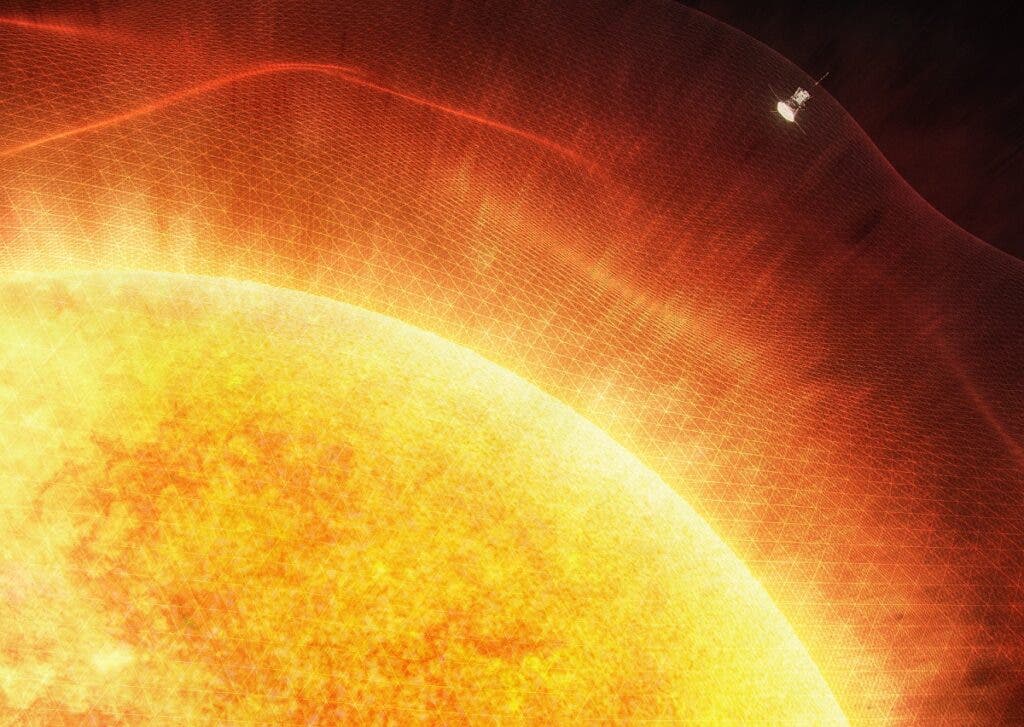The corona of the sun is two million degrees Fahrenheit (give or take). While exploring it was mostly regarded as a science fiction project, on April 28, NASA was able to put a spacecraft inside the flaming inferno. Using materials such as tungsten, niobium, molybdenum and sapphire, the Parker Solar Probe spent five hours in the sun’s extended solar atmosphere, marking a big leap for solar science.
“This marks the achievement of the primary objective of the Parker mission and a new era for understanding the physics of the corona,” said Justin C. Kasper, coauthor of the study which was recently published in Physical Review Letters. “The concept of sending spacecraft into the magnetized atmosphere of the sun—sufficiently close that the magnetic energy is greater than both ion and electron kinetic and thermal energy—predated NASA itself.”
The corona is the outermost layer of the Sun’s atmosphere where strong magnetic fields bind plasma and prevent turbulent solar winds from escaping. When solar winds top a speed fast enough to break free from the corona and the Sun’s magnetic fields, they have reached the so-called Alfvén point — the boundary where the point where the magnetic and kinetic energy of the plasma are equal. Many scientists believe that zig-zags in the sun’s magnetic field, called switchbacks, emerge from this area.
Previously, how and where they formed was a mystery. Prior to April 28, when the Parker Probe entered the corona three times, the spacecraft had been flying just beyond this point.
“If you look at close-up pictures of the Sun, sometimes you’ll see these bright loops or hairs that seem to break free from the Sun but then reconnect with it,” said Michael Stevens, an astrophysicist at the Center for Astrophysics | Harvard & Smithsonian. “That’s the region we’ve flown into — an area where the plasm, atmosphere and wind are magnetically stuck and interacting with the Sun…We know that the energy comes from the churning magnetic fields bubbling up through the surface of the sun, but we do not know how the Sun’s atmosphere absorbs this energy.”
Surprisingly, the researchers noticed that the Alfvén critical surface is not smooth, but wrinkled. The data suggest that the largest and most distant wrinkle of the surface was produced by a pseudostreamer—a large magnetic structure more than 40 degrees across, and found back on the innermost visible face of the sun. It is not presently understood why a pseudostreamer would shove the Alfvén critical surface away from the sun.
Researchers observed far fewer switchbacks below the Alfvén critical surface than above it. The discovery could mean that switchbacks do not form within the corona. Alternatively, low rates of magnetic reconnection on the Sun’s surface could have pumped less mass into the detected wind stream, resulting in a smaller number of switchbacks.
Interestingly, the spacecraft also found some unknown physics that could be affecting the Sun’s heating and dissipation.
“We have been observing the Sun and its corona for decades, and we know there is interesting physics going on there to heat and accelerate the solar wind plasma,” said Nour E. Raouafi, the Parker Solar Probe Project Scientist at Johns Hopkins University Applied Physics Laboratory. “Still, we cannot tell precisely what that physics is. With Parker Solar Probe now flying into the magnetically-dominated corona, we will get the long-awaited insights into the inner workings of this mysterious region.”
The Parker Probe was launched in 2018 with the goal of reaching humanity’s first star. This was its eighth interaction with the Sun. Other data gleaned from the probe include discoveries including explosions that create space weather and the dangers of super-speedy dust. In addition to the data inside the corona, thanks to solar winds, the probe will also be the fastest craft ever created, zipping along at 430,000 mph (690,000 kph) by 2025. That’s 0.064% the speed of light.
“It is hard to overstate the significance of both the event and the observations made by Parker Solar Probe,” said Gary Zank, a coinvestigator on the probe’s Solar Wind Electrons Alphas and Protons instrument. “For over 50 years, since the dawn of the space age, the heliospheric community has grappled with the unanswered problem of how the solar corona is heated to well over a million degrees to drive the solar wind. The first measurements of the sub-Alfvénic solar wind may represent the most major step forward in understanding the physics behind the acceleration of the solar wind.”



